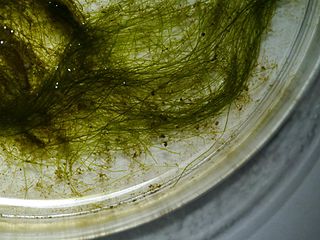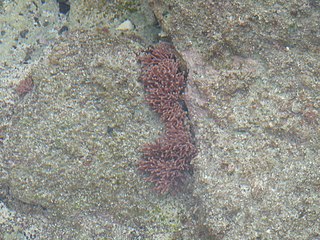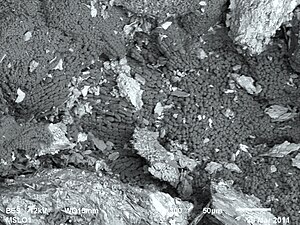
Coralline algae are red algae in the order Corallinales. They are characterized by a thallus that is hard because of calcareous deposits contained within the cell walls. The colors of these algae are most typically pink, or some other shade of red, but some species can be purple, yellow, blue, white, or gray-green. Coralline algae play an important role in the ecology of coral reefs. Sea urchins, parrot fish, and limpets and chitons feed on coralline algae. In the temperate Mediterranean Sea, coralline algae are the main builders of a typical algal reef, the Coralligène ("coralligenous"). Many are typically encrusting and rock-like, found in marine waters all over the world. Only one species lives in freshwater. Unattached specimens may form relatively smooth compact balls to warty or fruticose thalli.

Gracilaria, also known as irish moss or ogonori, is a genus of red algae in the family Gracilariaceae. It is notable for its economic importance as an agarophyte meaning that it is used to make agar, as well as its use as a food for humans and various species of shellfish. Various species in the genus are cultivated among Asia, South America, Africa and Oceania. They produce over 90% of the world's agar.

Chordariaceae is a family of brown algae. Members of this family are may be filamentous, crustose with fused cells at the base, or they may be terete and differentiated into a central medulla and an outer photosynthetic cortex. They have a sporphytic thallus usually aggregated to form a pseudo-parenchyma.

Mikael Heggelund Foslie was a Norwegian botanist and algaeologist. Foslie was curator of the Royal Norwegian Scientific Society Museum in Trondheim.
The history of phycology is the history of the scientific study of algae. Human interest in plants as food goes back into the origins of the species, and knowledge of algae can be traced back more than two thousand years. However, only in the last three hundred years has that knowledge evolved into a rapidly developing science.

Conceptacles are specialized cavities of marine and freshwater algae that contain the reproductive organs. They are situated in the receptacle and open by a small ostiole. Conceptacles are present in Corallinaceae, and Hildenbrandiales, as well as the brown Fucales. In the Fucales there is no haploid phase in the reproductive cycle and therefore no alternation of generations. The thallus is a sporophyte. The diploid plants produce male (antheridia) and female (oogonia) gametangia by meiosis. The gametes are released into the surrounding water; after fusion, the zygote settles and begins growth.

The Corallinaceae are one of the two extant Coralline families of red algae; they are differentiated from the morphologically similar Sporolithaceae by their formation of grouped sporangial chambers, clustered into sori. The Corallinoideae is monophyletic; the other subfamilies form another monophyletic group.
Phymatolithon is a genus of non geniculate coralline red algae, known from the UK, and Australia. It is encrusting, flat, and unbranched; it has tetrasporangia and bisporangia borne in multiporate conceptacles. Some of its cells bear small holes in the middle; this distinctive thallus texture is termed a "Leptophytum-type" thallus surface, and has been posited as a taxonomically informative character. It periodically sloughs off its epithallus, reducing its overgrowth by algae by as much as 50% compared to bare rock.

Halymenia a genus of a macroscopic red algae that grows in oceans worldwide.

Vaucheria is a genus of Xanthophyceae or yellow-green algae known as water felt. It is one of only two genera in the family Vaucheriaceae. The type species of the genus is Vaucheria disperma.

Porolithon is a genus of red algae comprising 24 species. The Porolithon are the primary reef building algae. When coral reefs reach sea level, the corals break under the high energy impact of the waves, while the coralline red algae, primarily Porolithon, continuing building and cementing the reef structure.

Amphiroa is a genus of thalloid red algae under the family Corallinaceae.

Jania is a genus of red macroalgae with hard, calcareous, branching skeletons in the family Corallinaceae.

Laurencia is a genus of red algae that grow in temperate and tropical shore areas, in littoral to sublittoral habitats, at depths up to 65 m (213 ft).

Erythrotrichia is a red algae genus in the family Erythrotrichiaceae. In Iceland, E. carnea is red listed as a vulnerable species (VU).

Ectocarpus is a genus of filamentous brown alga that includes a model organism for the genomics of multicellularity. Among possible model organisms in the brown algae, Ectocarpus was selected for the relatively small size of its mature thallus and the speed with which it completes its life cycle. Tools available for Ectocarpus as a model species include a high quailty genome sequence and both forward and reverse genetic methodologies, the latter based on CRISPR-Cas9.
Sporolithon is a genus of red coralline algae in the family Sporolithaceae, in the order Corallinales.


















